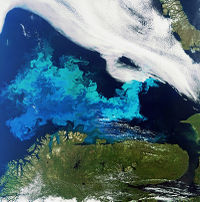Difference between revisions of "Portal:Eutrophication"
From MarineSpecies Introduced Traits Wiki
| Line 11: | Line 11: | ||
<div style="float:left; width:55%;"> <!-- This width add to the the margin below to equal 99%--> | <div style="float:left; width:55%;"> <!-- This width add to the the margin below to equal 99%--> | ||
| − | |||
| − | |||
{{/box-header|In the news|{{FULLPAGENAME}}/News|}} | {{/box-header|In the news|{{FULLPAGENAME}}/News|}} | ||
Revision as of 15:38, 30 March 2012
edit
Eutrophication
Eutrophication ('eu' = true or well; 'trophy' = food) is a leading threat to water quality around the world. In the North Sea and English Channel, the phenomenon is related to two major activities: agriculture and industry. This gives an excess of nutrients (nitrates, phosphates,...) in the water. This enrichment promotes the growth of algae. A small increase in algal biomass does not have any adverse effect on the ecosystem and can even result in an increase in certain fish populations. An over-stimulation of the growth of algae (an algal bloom), however, can lead to turbidity of the water. When the algae die, the water may be temporarily low in oxygen (hypoxia) what can result in the death of many fish.
edit
WikiProjects
edit
Things to do
edit
Wikimedia
What are Portals? | List of portals

